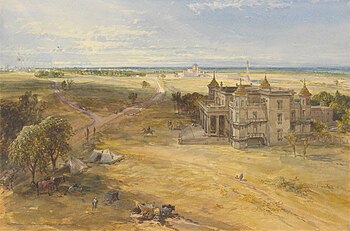Dilkusha Kothi
The house was constructed around 1800 by the British resident Major Gore Ouseley,[2] a friend of the ruler of Oudh, Nawab Saadat Ali Khan.
[1] The design bears a startling resemblance to the style of Seaton Delaval Hall in Northumberland, England.
Dilkusha Kothi is depicted in a rare early albumen print by the photographer Samuel Bourne, dating from 1864–1865.
[3] The British actress Mary Linley Taylor was impressed by Dilkusha Kothi and named her own home in Seoul after it.
This story is less notable given that the Frenchman Claude Martin who had been a neighbour when his palace of Constantia, later La Martinière Boys College, was started in the 1790s.
In 1857 the house was occupied by Indian rebels before being recaptured by British forces under the instructions of Sir Colin Campbell.
[1] The Archaeological Society of India has done work to prevent further decay, carrying out gardening and small repairs.





